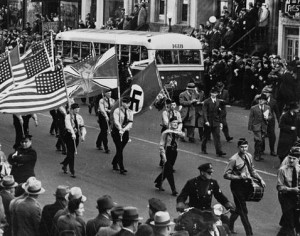What US actions might have averted World War II?
American Yawp, chapter 24, World War II
- I. Introduction
- II. The Origins of the Pacific War
- III. The Origins of the European War
- IV. The United States and the European War
- V. The United States and the Japanese War
- VI. Soldiers’ Experiences
Overview
 The 1940s witnessed the worst military conflict in world history. Out of more than 70 million combatants from 70 different countries, the editors at Digital History estimate about 17 million dead, including about 400,000 American military personnel out of more than 15 million in uniform. All of those figures exclude other types of casualties (such as wounded) and also civilian deaths, which vary widely by source, but which probably exceeded 50 million overall, included nearly 6 million European Jews in Nazi death camps. There had been plenty of warnings of impending conflict, but nothing that could have anticipated this type of carnage. Americans seemed especially determined to learn lessons from this immense bloodletting. The United States was not really isolationist in the years between 1919 and 1941, but there had been a palpable sense of disconnection with the rising tide of problems in Europe and Asia. As Russell Baker put it in his memoir, Growing Up, “worlds were burning, but they seemed far away.” Baker remembers his family mocking the “sausage-stuffers” of the German American Bund (pictured above, marching in New York in 1939). His mother memorably claimed in 1939, while they lived in Baltimore, that “This is England’s war. Let England fight it.” Yet once the Japanese launched a surprise attack on Pearl Harbor on December 7, 1941, such cautious sentiment shifted dramatically. Under the leadership of Franklin Roosevelt, the United States quickly moved to engage in the global conflict on multiple fronts, not only in the Pacific against Imperial Japan, but also in support of the Allied powers in the European fight against Nazi Germany and Fascist Italy. The war turned much of the politics of the previous generation upside down. The US was now allied with the Soviet Union. American men and materials were being rushed overseas. Women were working and contributing mightily to the war effort on what was called the “homefront.” There were also periods of terrible panic, such as the decision to relocate Japanese and Japanese-Americans on the West Coast to internment camps. Throughout this turbulent period, however, the United States continued to lead what many were already calling the “united nations” against a range of totalitarian threats. There was still some signs of economic, social and racial troubles at home, but the national focus had generally moved away from the kind of domestic concerns that had dominated during the Great Depression.
The 1940s witnessed the worst military conflict in world history. Out of more than 70 million combatants from 70 different countries, the editors at Digital History estimate about 17 million dead, including about 400,000 American military personnel out of more than 15 million in uniform. All of those figures exclude other types of casualties (such as wounded) and also civilian deaths, which vary widely by source, but which probably exceeded 50 million overall, included nearly 6 million European Jews in Nazi death camps. There had been plenty of warnings of impending conflict, but nothing that could have anticipated this type of carnage. Americans seemed especially determined to learn lessons from this immense bloodletting. The United States was not really isolationist in the years between 1919 and 1941, but there had been a palpable sense of disconnection with the rising tide of problems in Europe and Asia. As Russell Baker put it in his memoir, Growing Up, “worlds were burning, but they seemed far away.” Baker remembers his family mocking the “sausage-stuffers” of the German American Bund (pictured above, marching in New York in 1939). His mother memorably claimed in 1939, while they lived in Baltimore, that “This is England’s war. Let England fight it.” Yet once the Japanese launched a surprise attack on Pearl Harbor on December 7, 1941, such cautious sentiment shifted dramatically. Under the leadership of Franklin Roosevelt, the United States quickly moved to engage in the global conflict on multiple fronts, not only in the Pacific against Imperial Japan, but also in support of the Allied powers in the European fight against Nazi Germany and Fascist Italy. The war turned much of the politics of the previous generation upside down. The US was now allied with the Soviet Union. American men and materials were being rushed overseas. Women were working and contributing mightily to the war effort on what was called the “homefront.” There were also periods of terrible panic, such as the decision to relocate Japanese and Japanese-Americans on the West Coast to internment camps. Throughout this turbulent period, however, the United States continued to lead what many were already calling the “united nations” against a range of totalitarian threats. There was still some signs of economic, social and racial troubles at home, but the national focus had generally moved away from the kind of domestic concerns that had dominated during the Great Depression.
Timeline
1931 // Manchurian incident and Japanese takeover
1932 // Stimson Doctrine
1933 // Hitler seizes emergency powers in Germany
1935-39 // Congress adopts a series of neutrality acts
1937 // Japanese invasion of China (Rape of Nanking)
1938 // Munich Conference
1939 // Germans invade Poland; start of WWII in Europe
1940 // Roosevelt elected to unprecedented third term
1941 // (March) Lend-Lease Act
1941 // (June) Hitler breaks pact with Stalin; Germans invade USSR
1941 // (December) Pearl Harbor
Featured Document: America First Committee
Speech by Charles Lindbergh (1941)
There are many … interventionists in America, but there are more people among us of a different type. That is why you and I are assembled here tonight. There is a policy open to this nation that will lead to success–a policy that leaves us free to follow our own way of life, and to develop our own civilization. It is not a new and untried idea. It was advocated by Washington. It was incorporated in the Monroe Doctrine. Under its guidance, the United States became the greatest nation in the world.
It is based upon the belief that the security of a nation lies in the strength and character of its own people. It recommends the maintenance of armed forces sufficient to defend this hemisphere from attack by any combination of foreign powers. It demands faith in an independent American destiny. This is the policy of the America First Committee today. It is a policy not of isolation, but of independence; not of defeat, but of courage. It is a policy that led this nation to success during the most trying years of our history, and it is a policy that will lead us to success again….
The time has come when those of us who believe in an independent American destiny must band together and organize for strength. We have been led toward war by a minority of our people. This minority has power. It has influence. It has a loud voice. But it does not represent the American people. During the last several years I have traveled over this country from one end to the other. I have talked to many hundreds of men and women, and I have letters from tens of thousands more, who feel the same way as you and I.

